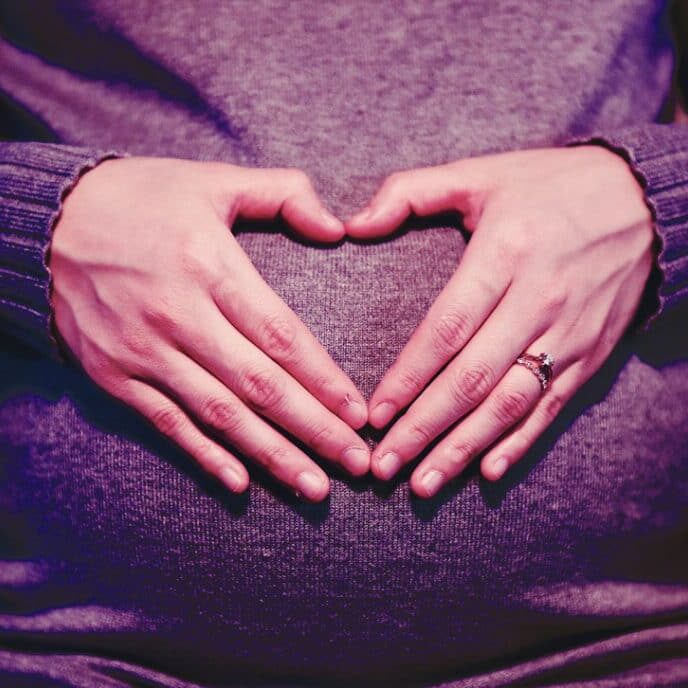Integrative Health|Pregnancy Wellness
Acupressure Points To Support Early Pregnancy

Acupressure is an alternative therapy, part of Traditional Chinese Medicine (TCM), that involves applying pressure to specific points on the body to stimulate healing and relieve various ailments, including pain and discomfort during pregnancy. However, it’s essential to consult with a healthcare provider before trying any alternative therapies during pregnancy to ensure they are safe for you and your baby.
Here are some acupressure points, or acupoints, that are commonly used for addressing pregnancy-related issues that are safe to use in the first trimester:
- P6 (Nei Guan): Located on the inner forearm, about two-and-a-half finger widths from the wrist crease, this point is believed to relieve morning sickness, nausea, and vomiting during pregnancy. Pressure point P6 is also known as the “Inner Gate” or “Inner Pass” and can also help with anxiety, stress, and wrist pain.
- BL32 (Ciliao): Located in the lower back, about two finger widths to the side of the spine at the level of the second lumbar vertebra, midway between the spin and the dimple of the buttocks, BL32, also known as Bladder 32, is often used for alleviating lower back pain and discomfort during pregnancy.
- GB21 (Jian Jing): Situated on the shoulder, halfway between the base of the neck and the edge of the shoulder, this point is thought to help with neck and shoulder tension, as well as headaches. GB21 (Gallbladder 21) is also known as the “Shoulder Well” point.
- KD3 (Tai Xi): Found on the inner ankle, between the ankle bone and the Achilles tendon, KD3 is believed to help with overall relaxation and balance, which can be beneficial during pregnancy. KD3 (Kidney 3) helps stimulate the pericardium which improves blood flow and circulation of Qi (energy).
- LV3 (Tai Chong): Located on the top of the foot, in the depression between the big toe and the second toe’s tendons, LV3 is thought to help with emotional balance and relieve stress.
- CV6 (Qi Hai): This point is situated about two finger widths below the navel and is believed to help with digestive issues and abdominal discomfort during pregnancy.
- UB60 (Kunlun): On the back of the hand, this point is in the depression between the knuckles of the little and ring fingers, close to the palm. UB60 is thought to help relieve lower back pain and promote overall balance.
- PC8 (Lao Gong): Situated on the palm side of the hand, in the center of the palm, just below the middle finger. PC8 is sometimes used to alleviate heart-related discomfort and emotional tension.
- SP6 (Sanyinjiao): This point is situated on the inside of the leg, about four finger widths above the ankle. It is believed to help with various pregnancy discomforts, including nausea, insomnia, and lower back pain.
- HT7 (Shen Men): Located on the wrist, in line with the pinky finger, on the palm side. HT7 is believed to improve circulation to the heart and promote relaxation during pregnancy.
It’s crucial to apply gentle and controlled, but firm pressure to these acupressure points, especially during pregnancy. Always consult with a qualified acupressure practitioner or a healthcare provider before using acupressure as a complementary therapy during pregnancy. Acupressure should be used alongside conventional prenatal care, not as a replacement for it. Additionally, some acupressure points are contraindicated during pregnancy, so it’s essential to seek professional guidance.
Which Acupressure Points Induce Labor?
The following pressure points should be used with caution if you are nearing your due date or in latent active labor or first-stage labor. These points not only help with the induction of labour but also can be used to manage pain during labor.
- LI4 (He Gu): Found on the hand, in the webbing between the thumb and index finger, LI4, also known as Large Intestine 4, is thought to help with pain relief, headaches, and inducing labor when nearing full term (consult a healthcare provider before using this point for labor induction as it may hasten uterine contractions and cause changes in the cervix, such as cervical dilation).
- LV3 (Taichong): Located on the top of the foot, in the depression between the big toe and the second toe’s tendons. It’s associated with the Liver meridian and is thought to promote the smooth flow of energy, which may indirectly influence uterine contractions.
- GV20 (Baihui): Positioned at the top of the head, in the center, directly above the ears’ highest point. It may help promote relaxation and balance energy.
What are the Effects of Acupressure during Pregnancy?
Acupressure during the early trimesters of pregnancy can have several potential effects and benefits when applied safely and appropriately.
- Nausea Relief: Acupressure can help alleviate morning sickness and nausea, which are common early pregnancy symptoms. The P6 (Nei Guan) point on the inner forearm is often used for this purpose.
- Stress Reduction: Acupressure can promote relaxation and reduce stress and anxiety during the early trimester when emotional fluctuations and anxiety may be common.
- Balancing Energy: Acupressure is believed to balance the body’s energy flow (Qi) and can help with overall well-being and vitality during pregnancy.
- Enhanced Sleep: Some pregnant individuals experience difficulty sleeping during the early trimester. Acupressure can be used to promote better sleep patterns.
- Improved Digestion: Acupressure points can help alleviate digestive issues, such as bloating, indigestion, and constipation, which can occur during pregnancy.
- Emotional Balance: Pregnancy can bring about emotional changes, and acupressure may help stabilize mood swings and promote a sense of emotional well-being.
- Relief from Aches and Pains: Acupressure can be used to address mild aches and pains that may arise during the early trimester, such as lower back discomfort.
- Boosting Immune Function: Strengthening the immune system through acupressure may help pregnant individuals stay healthier during pregnancy.
Are Acupuncture Points The Same As Acupressure Points?
Acupressure points and acupuncture points are closely related, but they are not exactly the same. Both acupressure and acupuncture are part of TCM and are based on the concept of meridians and energy flow in the body, but acupuncture is performed by a licensed acupuncturist.
Acupuncture can offer several potential benefits for pregnant women when administered by a qualified and experienced acupuncturist. It is generally considered safe during pregnancy when performed by a skilled practitioner. Some of the benefits of acupuncture for pregnant women include:
- Morning Sickness Relief: Acupuncture may help alleviate nausea and vomiting associated with morning sickness, providing relief during the early stages of pregnancy.
- Pain Management: Acupuncture can help manage various types of pregnancy-related pain, including lower back pain, sciatica, pelvic pain, and joint discomfort.
- Stress Reduction: Pregnancy can be emotionally challenging, and acupuncture may promote relaxation and reduce stress and anxiety.
- Hormonal Balance: Acupuncture is believed to help regulate hormonal imbalances, potentially addressing issues such as irregular menstrual cycles or fertility challenges.
- Labor Preparation: Some studies suggest that acupuncture may help prepare the body for labor by promoting cervical ripening and reducing the need for medical induction.
- Breech Presentation Correction: Acupuncture techniques, such as the use of moxibustion, may be employed to encourage the fetus to turn from a breech position to a head-down position.
- Fatigue and Energy Enhancement: Acupuncture may help combat pregnancy-related fatigue by improving energy levels and overall vitality.
- Swelling and Edema Reduction: Acupuncture can help reduce mild swelling (edema) in the feet and ankles that sometimes occurs during pregnancy.
- Sleep Improvement: Some pregnant women experience difficulty sleeping, and acupuncture may promote better sleep patterns.
- Blood Pressure Regulation: Acupuncture can be used to help regulate blood pressure, which is crucial for maintaining a healthy pregnancy.
- Immune System Support: Strengthening the immune system through acupuncture may help pregnant women stay healthier during pregnancy.
- Digestive Comfort: Acupuncture may alleviate digestive issues, such as constipation, heartburn, and indigestion, which can occur during pregnancy.
It’s essential to consult with a qualified healthcare provider and seek out an acupuncturist with experience in prenatal care before undergoing acupuncture during pregnancy. The acupuncturist should be aware of your specific pregnancy-related concerns and tailor the treatment accordingly. Additionally, make sure the acupuncturist follows safety guidelines and uses sterile, single-use needles to reduce any potential risks.
Closing Thoughts: Who is Debra Betts?
Debra Betts is a well-known practitioner and educator in the field of acupuncture and acupressure, with a particular focus on women’s health, pregnancy, and childbirth. She is widely recognized for her work in promoting the use of acupuncture and acupressure as complementary therapies during pregnancy and labor.
Debra Betts has authored books and educational materials on the use of acupressure for pregnancy and childbirth, and she has conducted workshops and training programs for healthcare professionals and acupuncturists. Her work has contributed to the growing interest and acceptance of acupuncture and acupressure as safe and effective methods for managing pain, reducing stress, and promoting well-being during pregnancy and childbirth.

























